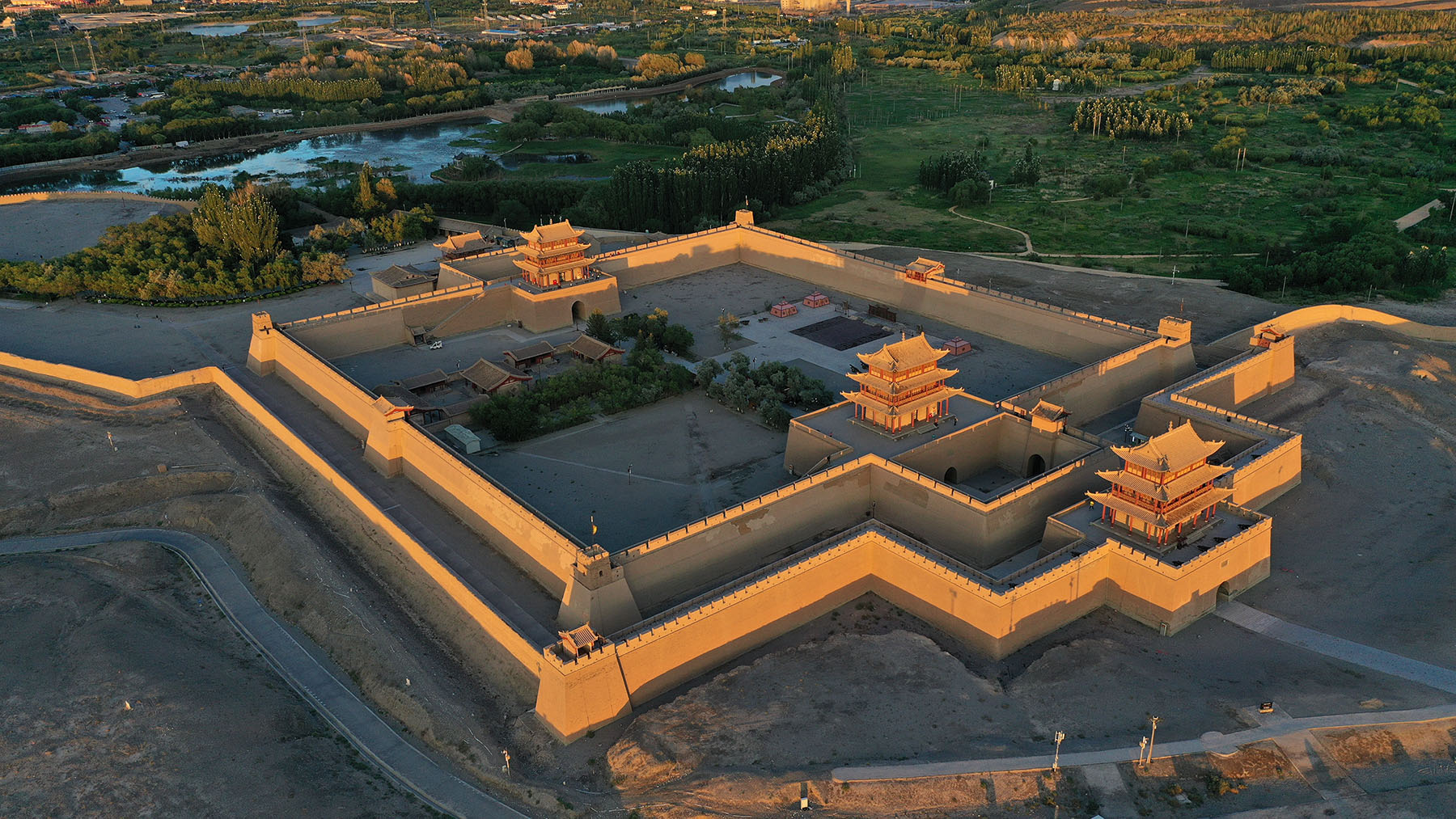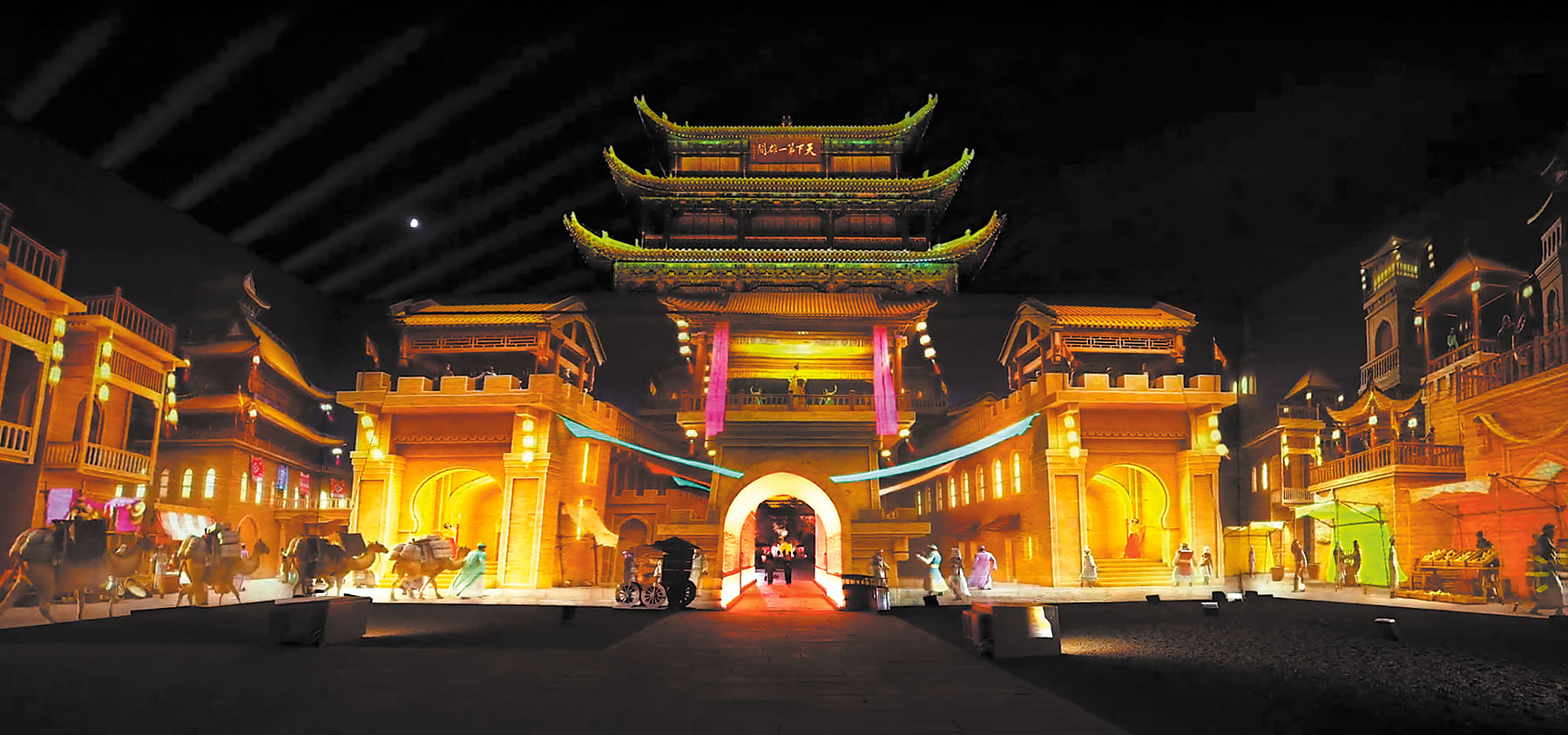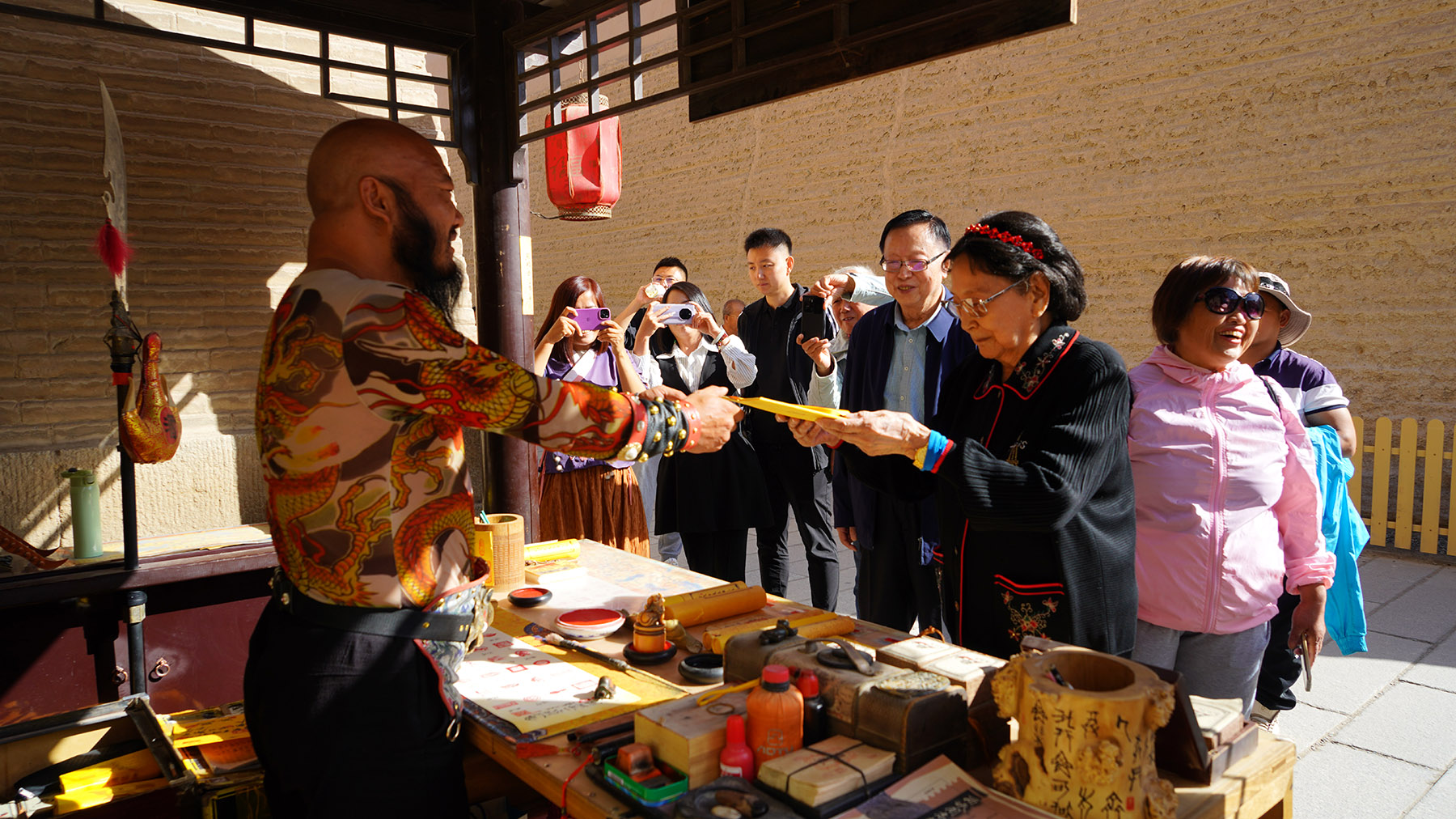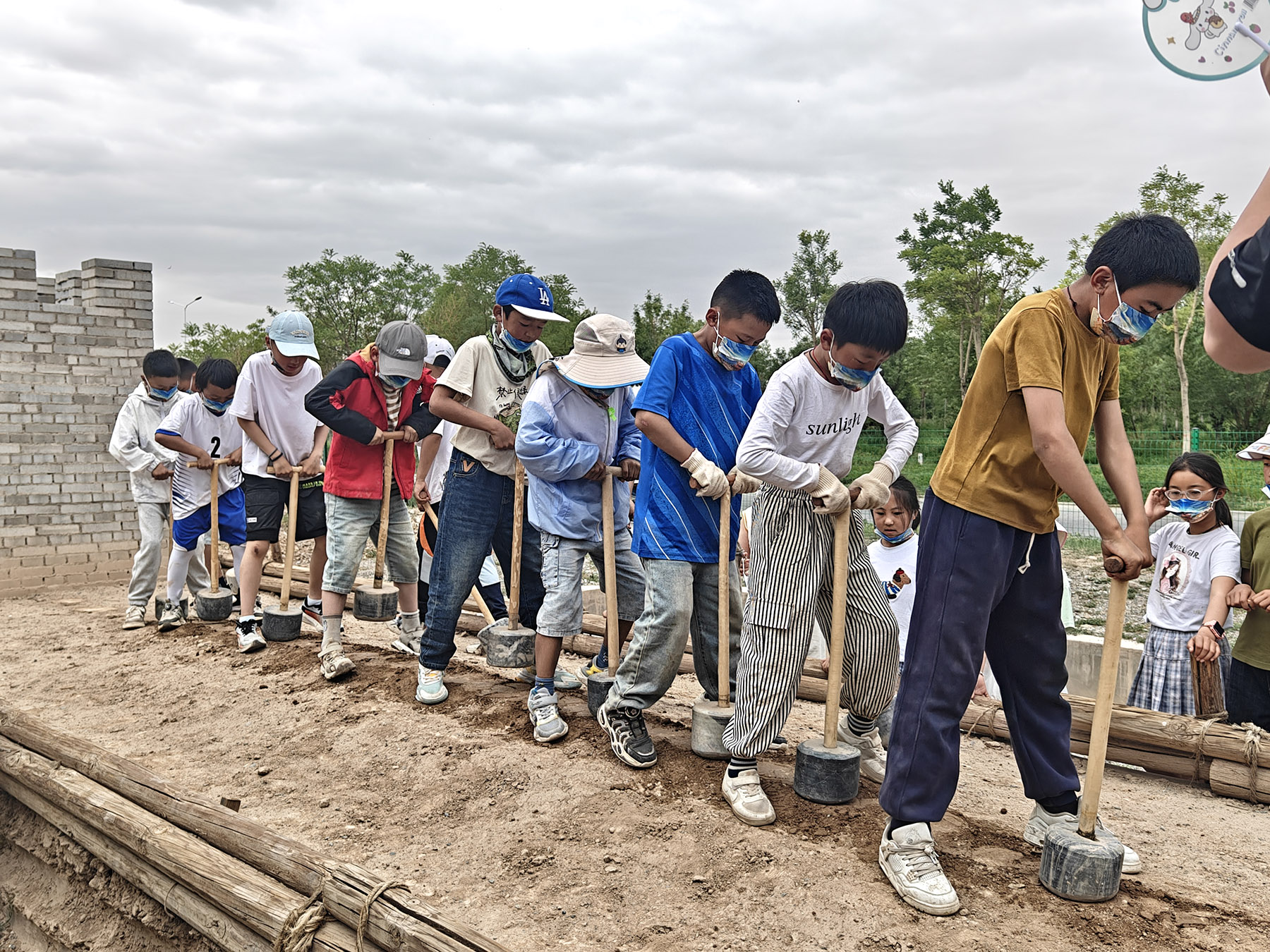Using immersive experiences and new technology, visitors to historical trade gateway get a taste of the past, Deng Zhangyu reports in Jiayuguan, Gansu.

Dressed in a dragon-patterned garment, self-styled "pass chief" Li Sen is busy issuing guanzhao — an ancient travel permit similar to today's passport — to visitors at the Jiayuguan Pass in Jiayuguan, Gansu province. The guanzhao gives visitors a role-play experience that replicates a passing ritual dating back hundreds of years.
As tourists announce their hometowns and names, Li recites the corresponding hometowns' historical names, uses a brush to write the ancient name on the simulated passport, and stamps it with a seal he engraved. The ritual activity is so popular that long queues form in front of the gate at the Jiayuguan Pass almost every day.
"I hope the guanzhao ritual bridges the gap between visitors and the heritage, particularly the culture and stories of the ancient pass," says Li, who has played the role of "pass chief" for over a decade.
READ MORE: The Great Wall of man and nature
Roughly a 15-minute drive from the city of Jiayuguan, the ancient pass built in the 14th century during the Ming Dynasty (1368-1644) served as a vital military stronghold and a crucial gateway for trade and cultural exchange along the ancient Silk Road. Foreign merchants and envoys from Central and Western Asia entering China, and Chinese merchants traveling west needed the guanzhao issued by local authorities to pass through checkpoints along the route.

To perfect his role, Li has handwritten and memorized more than 1,000 ancient city names and crafted various versions of the guanzhao on printed paper, woodblocks and scrolls since 2012. He even grows a beard and commissions a tailored general's armor, fully immersing himself in the character.
In addition to serving as the pass chief, Li also creates videos related to Jiayuguan Pass' culture and history and uploads them to online platforms. He currently has over 400,000 followers on Douyin, China's TikTok. He hopes that more people will learn about Jiayuguan through his work, visit it in person, experience its history, and learn about its culture.
Often referred to as the "First and Greatest Pass Under Heaven", Jiayuguan Pass is considered one of the most well-preserved passes, and it marks the western end of the Ming Dynasty Great Wall. The pass consists of the fortress, the Hanging Great Wall, located 8 kilometers to the north and built on the ridge of Heishan Mountain, and the First Beacon Tower to the south, which stands atop an 80-meter-tall river cliff.
Near the First Beacon Tower, there's also the Great Wall Museum, where visitors can learn about the wall sections and the pass.
Today, visitors to the Jiayuguan Pass are seeking more than just a simple tour. They prefer a deeper, culturally immersive experience, just like Li's guanzhao issuing ceremony, says Li Chenchao, general manager of the Jiayuguan Cultural Relics Scenic Area, where the Jiayuguan Fortress is situated.

Last year, the scenic area introduced holographic projection technology, and uses a light show to bring the stories of the Great Wall to life, using the walls as a vast canvas. This also marked the beginning of a new nighttime tourist experience at the ancient pass.
As night falls, the light show begins. Laser beams streak across the dark sky, instantly illuminating the entire fortress. The dramatic atmosphere of the Hexi Corridor and the heroic defense structure of the Great Wall come alive through the dynamic light display, making visitors feel as though they have traveled back in time to an era of heroes.
Li Chenchao says they hope to use technology to bring Great Wall culture to life in a more vivid and tangible way.
Complementing the mesmerizing light show are the omnipresent live performances scattered throughout the area. Armored soldiers can be seen either patrolling the pathways or reenacting ceremonies that mark their departure for the battlefield. Actors dressed in ancient costumes appear spontaneously, engaging the audience in interactive song and dance performances.
"These immersive experiences bring artifacts and history to life, allowing visitors to experience the Great Wall in a more vivid, engaging way," he says.

Last year, the number of visitors to the scenic area exceeded 3.8 million, a 41 percent increase compared to 2023. Particularly noteworthy was Aug 5 of last year, when the number of visitors reached 53,000 in a single day, setting a new record, adds Li Chenchao.
Nestled amid the stunning landscapes of the Gobi Desert and the snow-capped Qilian Mountains, Jiayuguan Pass offers breathtaking natural scenery during the day. At night, tourists can immerse themselves in the rich history through captivating light displays and performances.
"Many visitors who explore during the day choose to return in the evening to experience a different kind of scenery," Li Chenchao says.
With the growing popularity of cultural study tours among teenagers, the scenic area has designated a large space as a site for educational activities. The most popular program is the hands-on experience of building the Great Wall.
Under the guidance of teachers, participants spend an hour learning how the wall was constructed, including tasks such as sifting soil, tamping bricks and stones, and transporting materials. The entire process follows the ancient methods used in building the Great Wall.

Li Chenchao says more technologies, such as augmented reality and virtual reality, will be used next year and enhance visitor services, without causing damage to the walls and the pass, as development through preservation is of utmost importance.
"The city of Jiayuguan was established because of the ancient pass. The last general guarding the Jiayuguan Pass was named Rui Ning, and we often joke that each of us is a modern-day Rui Ning, a gatekeeper bearing the responsibility of protection," adds Li Chenchao, who grew up in the city.
According to Great Wall protection expert Niu Haipeng, the process has now entered a completely new stage, transitioning from the rescue-oriented conservation efforts of the last century to the current preventive measures. Additionally, public awareness has significantly increased.
Niu, deputy director of the Cultural Relics Management Office of the Great Wall with the Jiayuguan Great Wall Research Institute, recalls that, in the last century, some farmers would take home the sandy soil from near the Great Wall, to fertilize their fields. Now, villagers living around the wall are volunteering to patrol and protect it.
ALSO READ: Dancing for Dunhuang
Every day, cultural heritage personnel conduct real-time monitoring of the Great Wall in the vast Gobi Desert. This includes over 43 km of the wall, as well as various passes and beacon towers.
The current damage is mainly caused by the natural environment and climate change. For example, they need to monitor humidity, wind strength, wall cracks and extreme weather conditions, such as heavy rain, in real time.
"Leveraging technology to enhance protection has also been a focus of our ongoing efforts. We use drones for monitoring and employ various instruments, such as anemometers and crack detectors. We are also collaborating with many universities and institutions to carry out digitalization of the Great Wall in Jiayuguan," says Niu.
Contact the writer at dengzhangyu@chinadaily.com.cn


